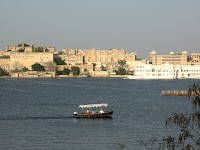say "Udaipur", now sigh . . .

Udaipur was our second stop in India. Visiting the City Palace, the Monsoon Palace, and other sights - or even just staring at the City Palace from the opposite bank of Lake Pichola where our hotel is situated, seeing the brilliantly white Lake Palace (a building that took up all the space on a tiny island, seeming to float on the water - see the photo on the right) - one is left feeling like you've stepped into a story land minus the kitsch of theme parks.
The buildings are mostly about 300 years old. Not much seems to have been done recently to prettify them, and this is the case even with the palaces that have been converted into hotels. Walking in their courtyards and rooms, you smell something unfamiliar, especially to the Singaporean nose. It is the smell of buildings and places left to age. And you wonder about the scenes that these walls have witnessed. I was entranced by Udaipur, a city of the impossible dream pursued to creation (man-made lakes in a desert), a city with a sense of the drama of light.

The city became the locus of fantasies made real when the political powers of the royal family were emptied by British colonial rule and the Maharana and his family turned their attention to ostentation and hobbies. You get a sense of this from so much of what makes the city magical. The photo on the right was taken after we had walked through the Crystal Gallery, the collection of the royal family's European crystal furniture including a sofa set, a dining set, and a four-poster bed; crystal chandeliers and lamps of different sizes; crystal tableware; even crystal fly swatters. There was also a whole row of green Murano glass chandeliers - as if to say, we're not just into the best British crystal makers, we know about Venetian glass too.

What I love most about Udaipur's City Palace is that it's actually made up of several palaces. Because each subsequent king added his own rooms to the complex, you could be standing in a chamber that was built and decorated in the 17th century and find that the neighbouring room was constructed 200 years later. There were so many surprises, including my personal favourite: walking through a narrow passageway, climbing a thin flight of stairs, seeming to have gone deep into the heart of the building, but only to find as you emerge from the stairwell, a courtyard not unlike the quads in an Oxbridge college! It is the sort of place that makes me want to sit down and re-read an Italo Calvino novel. Or to make up one of my own. . .
 This is a dusk picture of the Aravalli hills that go all the way from Rajasthan to New Delhi. It was taken from a coign at the top of the Monsoon Palace. It's possibly the first time I've looked at a view and felt that the word "sublime" may have been coined for making language feel, sorely, its inadequacy.
This is a dusk picture of the Aravalli hills that go all the way from Rajasthan to New Delhi. It was taken from a coign at the top of the Monsoon Palace. It's possibly the first time I've looked at a view and felt that the word "sublime" may have been coined for making language feel, sorely, its inadequacy.




